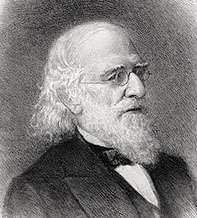Isaac Lea
Isaac Lea (March 4, 1792 – December 8, 1886) was an American conchologist, geologist, and publisher, who was born in Wilmington, Delaware.[2]
Isaac Lea | |
|---|---|
 | |
| Born | March 4, 1792 |
| Died | December 8, 1886 (aged 94) Philadelphia, Pennsylvania[1] |
| Nationality | American |
| Spouse(s) | Frances Ann Carey
( m. 1821; died 1873) |
| Children | 3 (incl. Henry and Mathew) |
| Relatives | Mathew Carey (father-in-law) |
Early and family life
Although born a Quaker (his grandfather John Lea having emigrated to the New World with William Penn in 1700 and preached at Friends' meetings), Isaac Lea forsook his faith's traditional pacificism and joined the 7th Company of the 24th Pennsylvania Militia and fought in the War of 1812. After hostilities ended, on March 8, 1821, he married Frances Ann Carey (1799–1873), daughter of Irish-American publisher Mathew Carey, based in Philadelphia. Their first son died as an infant, but the following two sons survived, were tutored by leading mathematician Eugenius Nulty, and ultimately achieved distinction in scholarly fields and the family publishing business. The brothers married the Jaudon sisters and their children also joined the family business, which ultimately became Lea & Febinger. Henry Charles Lea (September 19, 1825 – October 24, 1909) was an American historian, civic reformer, and political activist in Philadelphia. Mathew Carey Lea (1823–1897) became a lawyer as well as founder of mechanochemistry and early photographer.
Publishing career
Mathew Carey retired in 1825, leaving his prosperous business in the hands of his son Henry Charles Carey and son-in-law Isaac.[2][3] The publishing house became one of the most successful in America, publishing among others The Encyclopedia Americana, a dictionary of German lexicon, as well as American editions of the works of Walter Scott and James Fenimore Cooper. The firm promoted William A. Blanchard to partner in 1833, and when Mathew Carey died in 1838 and Henry Carey retired in 1846, the publishing house's name changed to Lea & Blanchard, and it became Lea Brothers when his sons entered into the business and Isaac himself retired to pursue his scientific interests.[3][4] In the 1840s, the Careys were staunch nationalists and economic protectionists.
Scientific career
Isaac Lea devoted his leisure time to natural history, both collecting objects and publishing books (some illustrated by his son Henry Charles Lea).[2] He was especially interested in freshwater and land mollusks, and for 50 years delivered and published scientific papers in the transactions of Philadelphia's scientific societies concerning these animals.[2]
He was a member (and for a time vice-president) of the American Philosophical Society and also served as President of the American Academy of Natural Sciences(1858–1863), both based in Philadelphia. Isaac Lea served as President of the American Association for the Advancement of Science in 1860.[5]
Death and legacy
He died on December 8, 1886, and is buried in Philadelphia's Laurel Hill Cemetery.[6] In 1829 Edgar Allan Poe wrote a poem dedicated to Lea called "To Isaac Lea".
The National Museum at Washington now has his immense collection of freshwater mussels from the family Unionidae, as well as other collections.[2][7]
The Historical Society of Pennsylvania has the records of Lea & Febinger, as well as predecessor companies.[8]
Publications
Isaac Lea's publications included:
- Lea, I. 1818. An account of the minerals at present known to exist within the vicinity of Philadelphia. Journal of the Academy of Natural Sciences of Philadelphia 1, 462–482. (BHL link)
- (1823) Complete, Historical, Chronological, and Geographical American Atlas
- (1827–1874). Observations on the Genus Unio. 13 volumes.
- (1833). Contributions to Geology
- (1837). "Observations on the Naiades". Transactions of the American Philosophical Society 5
- (1838). Synopsis of the Family of Naiades
- Lea I. (1838). "Description of New Freshwater and Land Shells". Transactions of the American Philosophical Society 6: 1–154.
- (1852). Fossil Footmarks in the Red Sandstones of Pottsville
- Lea, Isaac (1871-04-01). "Descriptions of Twenty New Species of Uniones of the United States". Proceedings of the Academy of Natural Sciences of Philadelphia. 23 (2): 189–193. ISSN 0097-3157. JSTOR 4624172.
Molluscan taxa named by Lea include:
- Euglandina vanuxemensis (Lea, 1834) – a carnivorous land snail
- Unio lawii (Lea, 1871[9]) – named for Annie Law
References
- This article incorporates text from a publication now in the public domain: Gilman, D. C.; Peck, H. T.; Colby, F. M., eds. (1905). New International Encyclopedia (1st ed.). New York: Dodd, Mead. Missing or empty
|title=(help)
- "Chlt.org".
- New International Encyclopedia
- "Biography of Matthew Carey". www2.vcdh.virginia.edu.
- "Publishers of Philadelphia < Carey & Lea, Printer and Publisher - Seasonal Variations in its Business Cycle 1833-1836 - Richard H. Gassan < 1801-1900 < Essays < American History From Revolution To Reconstruction and beyond". www.let.rug.nl.
- Baltzell, E. Digby (1958). Philadelphia Gentlemen. Glencoe, Illinois: The Free Press. p. 149.
- "Isaac Lea". www.findagrave.com. Retrieved 14 July 2020.
- "Isaac Lea Papers, 1832–1876". SIA RU007065. Smithsonian Institution Archives. Retrieved 9 April 2012.
- http://hsp.org/sites/default/files/legacy_files/migrated/findingaid227bleaandfebiger.pdf
- Lea, Isaac (1871-04-01). "Descriptions of Twenty New Species of Uniones of the United States". Proceedings of the Academy of Natural Sciences of Philadelphia. 23 (2): 189–193. ISSN 0097-3157. JSTOR 4624172.